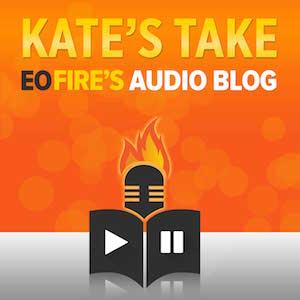
Have you ever stopped to think about just how much content you’ve created?
It’s easy to measure our content based on the results we’re seeing in our business. For example, I’m making $X per month, and therefore I’ve created a lot of great content.
Following this line of thought, there are probably many of us who think, I’m making $0 per month, and therefore I haven’t created any great content.
I felt this way when I started Kate’s Take.
The blog really hadn’t “taken off”, I never really received much feedback from my readers, and so even though I created over 100 posts on the blog, in my mind, I hadn’t really created much of anything.
When I started Kate’s Take, I knew I would be pulling from my previous posts to get started: because Kate’s Take was going to be an audio blog, I thought what better way to leverage the content I’ve already created than to repurpose it?
And so my first step to creating Kate’s Take was cataloguing my content.
Because I had in my mind that I hadn’t really created anything of great worth since I wasn’t getting actual feedback and validation from my readers in response to that content, I’d never thought about the mountains of content I actually had created.
Cataloguing it changed everything.
How I catalogued my content
It seemed like a monsterous project at the time.
Turns out, it was a monsterous project.
Lucky for me, we had a virtual team I could turn to for help.
The first step was actually documenting every post I had published, and so I delegating this task to one of our virtual assistants, JM.
I asked JM to create a Google Spreadsheet, and then to go back to the very first post I had ever published on the blog all the way up to the current day and record:
- Date the post went live
- Title of the post
- URL for the post
- Short / quick link for the post
- Social share stats (Twitter, Facebook, Google+)
Once JM had documented this all for me, I went in and added a column to the right of the title column and I labeled it “Category”.
Over the next week I went through every single post and I started categorizing them.
Here are a few of the categories I used:
- Inspiration / motivation
- List post
- Step-by-step / instructional
- How to get started
- Being an entrepreneur
- Podcasting
What I’ve described above isn’t groundbreaking. Seems pretty simple that you’d put a plan in place to catalogue your content, right?
But have you ever actually thought about doing this?
Have you thought about the benefits cataloguing your content can bring – benefits that go way beyond just the organizational peace of mind?
I hadn’t thought about the benefits – until I actually saw them for myself.
How cataloguing my content changed everything
Once I had this information in a single place, and I could sort the actual categories I had created and the hard data (social shares) that JM had recorded, I started to see patterns.
I didn’t think about this when I first started this project of cataloguing my content – my main goal in doing this was so that I had some sort of organization around actually launching Kate’s Take.
But what I realized is that I now had actual data that could help me understand my readers better. I mentioned that at the time I wasn’t really hearing from my readers – I wasn’t getting actual emails or comments that could give me feedback in response to the topics I was writing about.
Was I doing a good job?
Was the content I was creating helping people?
Even though I didn’t have direct feedback from my readers, cataloguing my content gave me indirect feedback from my readers.
I started to see that some of my list posts were WAY outperforming my being an entrepreneur posts because of the number of shares they were getting.
I started to see that my step-by-step posts were shared more than any of my other content, and for me, even though it wasn’t direct feedback from my readers, that helped me understand what type of content was performing best.
If you’re feeling like you can’t listen to your avatar because they’re not reaching out to you, then start finding other ways to listen.
For me, that was cataloguing my content. Once I did that, I was able to focus in on what type of content was performing best, and once I started creating more of that, I started growing my following. And once I started growing my following, my readers did start reaching out.
